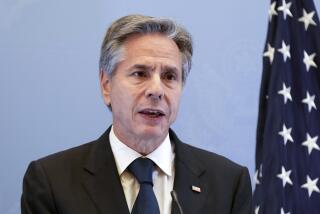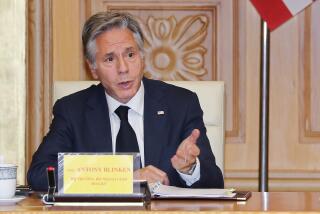Iranian website reports U.S. giving ground on nuclear centrifuges

The Obama administration has agreed to allow Iran to operate 6,000 centrifuges to enrich uranium, up from a proposed ceiling of 4,000 reported two weeks ago, as part of negotiations for a nuclear deal, according to a website approved by the Iranian government.
The claim appeared to be the latest sign that the pace of bargaining is intensifying between Iran and six world powers as they face a Nov. 24 negotiating deadline.
The two sides are seeking a comprehensive deal that would lift international sanctions on Iran’s economy in exchange for verifiable limits on Iran’s nuclear program to prevent the country from being able to build a bomb.
The size of Iran’s centrifuge inventory is a key sticking point in the talks that began in January.
Iran, which denies that it seeks to build a bomb, has insisted that it must maintain its current inventory to provide fuel for electricity and other peaceful purposes. It has 9,400 operating centrifuges and roughly 10,000 others that are not in operation.
The six world powers -- the United States, France, Britain, Russia, China and Germany -- want to reduce the number of centrifuges so Iran would require at least one year to attain a nuclear bomb-making capability should it decide to throw out international inspectors and race for such a weapon.
The Iranian website said the Obama administration has repeatedly given ground on the centrifuge count, starting early this year with a ceiling of 500 centrifuges, then being raised in negotiations to 1,500 and then 4,000.
The Persian-language irannuc.ir website is government approved, and is closely aligned with the viewpoint of Iran’s foreign ministry and national nuclear organization. It was unclear from the website, however, if the U.S. position is contingent on other details in a deal.
The White House declined comment Tuesday, saying it does not discuss details of the ongoing negotiations.
Skeptics of a potential deal, including many U.S. lawmakers and Israel, worry that the administration may be too lenient in allowing Iran to keep centrifuges. But it is not clear that 6,000 is a large enough inventory to galvanize political opposition to a deal in Congress and among allies.
“You really need to see the whole deal to know if it would be sellable in Washington,” said Ray Takeyh, an Iran specialist at the nonpartisan Council on Foreign Relations in Washington. “We’re only hearing about possible pieces of a deal.”
The disclosure comes as both sides appear to be leaking information from the closed-door talks to pressure the other side to make compromises, and to position themselves to deflect blame if the talks fail.
The New York Times, quoting senior administration officials, reported Monday that Iran has tentatively accepted a proposal to send most of its stockpile of enriched uranium to Russia to be made into fuel for Iranian nuclear power plants.
Such a move, which officials have proposed for a decade, could be an important ingredient in forging a final deal because it could significantly extend Iran’s “breakout time” to build a bomb should it decide to do so.
It thus could make it easier for the Obama administration and Congress to accept a larger centrifuge inventory, analysts said.
Russia has been a commercial nuclear partner of Iran for years and provides fuel for its power reactor at Bushehr.
In a statement, Bernadette Meehan, a spokeswoman for the National Security Council, declined comment on the proposed transfer of enriched uranium, but she praised Russia for playing a “very helpful role” in the negotiations.
The Iranians denied the report. Marzieh Afkham, a foreign ministry spokeswoman, described it as “speculations and rumors … circulated for political ends.”
Russian foreign ministry officials could not be reached for comment late Tuesday, but a senior analyst in Moscow said the issue has been under discussion for months.
“Such a compromise deal would be an option which should suit all parties involved in the process,” said Vladimir Sazhin of the Institute of Oriental Studies.
Mohammad Javad Zarif, Iran’s foreign minister, said in September that negotiators had found “a satisfactory way” to deal with the stockpile issue.
Iran has agreed in previous negotiations to ship out portions of its uranium stockpile to Russia or other countries, only to backtrack and reject the transfer as an infringement of national sovereignty.
A deal on centrifuges and enrichment capacity could be the key that opens the way for resolution of other outstanding issues between the two sides, analysts said.
Cliff Kupchan, an Iran watcher and chairman of the Eurasia Group risk consulting firm, said the leaks suggest “a deal is more likely today than it was two weeks or a month ago.”
Yet he and many others who closely follow the talks remain cautious as the deadline looms.
“We’re seeing Hail Mary passes now, toward the end of the game,” he said. “They’re throwing them, but that doesn’t mean there will be somebody there to catch them.”
Times staff writer Richter reported from Washington and special correspondent Mostaghim from Tehran. Staff writer Sergei L. Loiko in Moscow contributed to this report.
Follow @richtpau on Twitter for news out of the Iranian nuclear talks
More to Read
Start your day right
Sign up for Essential California for news, features and recommendations from the L.A. Times and beyond in your inbox six days a week.
You may occasionally receive promotional content from the Los Angeles Times.







